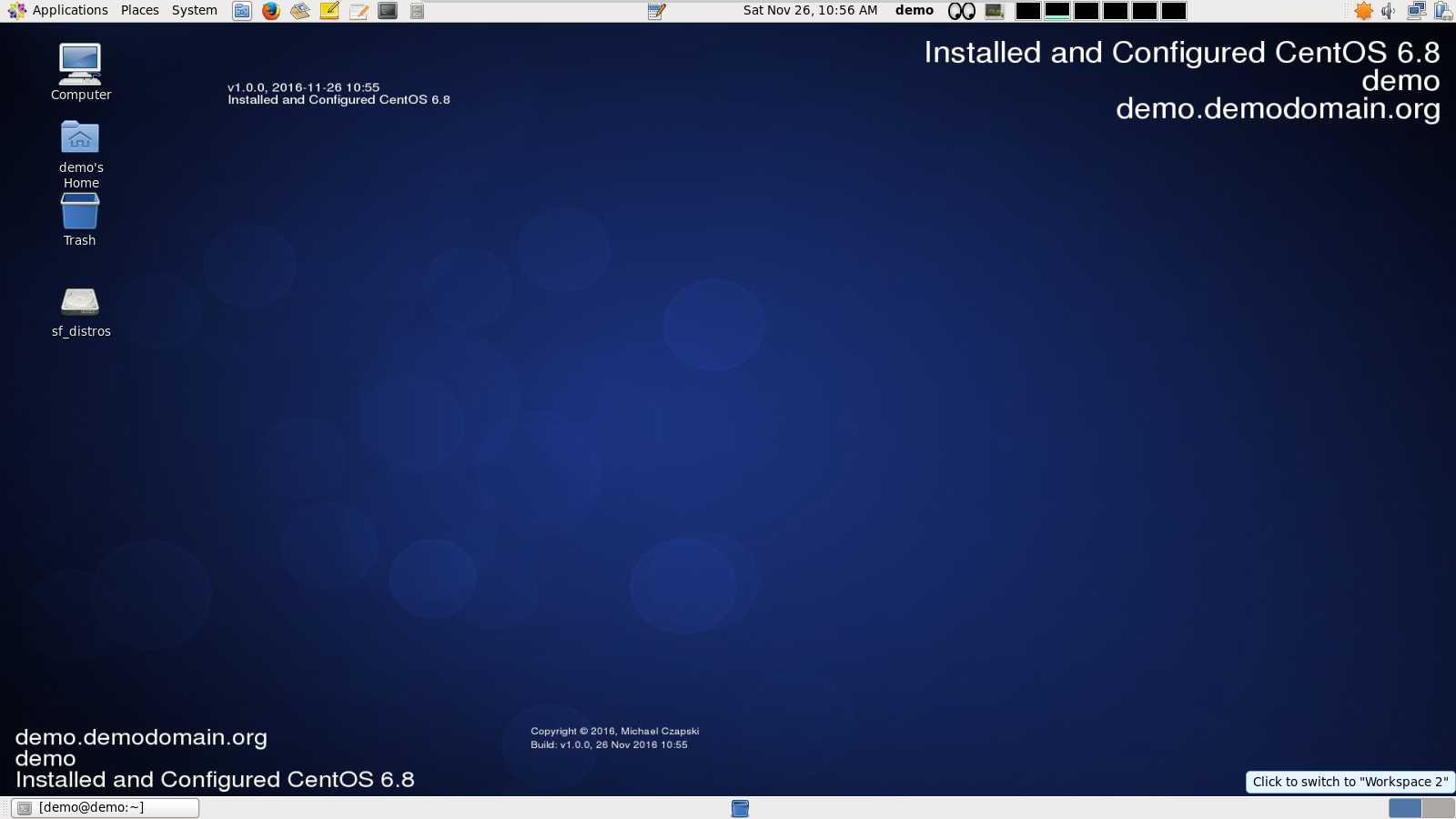Introduction
Please see the article “Build a Linux-based Infrastructure Solution Demonstration Series” (https://blogs.czapski.id.au/2016/10/build-a-linux-based-infrastructure-solution-demonstration-series) for rationale, introduction and links to articles in this series.
From time to time I may need another user account, configured with the same tools and settings as the demo user which was used in the earlier articles and will continue to be used in the subsequent articles.
In this post I show how a new user can be created and configured using the scripts which were already developed and which are available for use.
Pre-Requisites
This article assumes that
- The work is done in the Virtual Box Machine Image created in accordance with the instructions in the blog article to be found at https://blogs.czapski.id.au/2016/10/configure-virtual-box-virtual-machine-and-install-centos-6-8-base-image.
- The user “demo” has sudo access without a password. If this is not the case use the command “su -” and provide the password instead of saying “sudo -i” in the set of commands below
The instructions should work in other RedHat 6-like OS’ and OS versions.
Discussion
Let’s assume that we need another user’s environment configured the same way as the demo user’s environment. We were creating configuration scripts in the following articles:
- CentOS 6.8 – Script Adding Top Panel Applets – GEyes, ShowDesktop and Gnome Monitor
- CentOS 6.8 – Script adding a new gnome-terminal profile
- CentOS 6.8 – Create desktop branding scripts and brand desktop
Since the scripts are already available we will, in this article, create a different user, log in as that user, and execute the scripts to set up the environment.
Add user
Assuming that we are logged in as the demo user, which we will be if the article series was followed in the order in which it was published, we have sudo access.
NewUsername=ademo2
sudo useradd -c "${NewUsername} User" -m ${NewUsername}
sudo passwd ${NewUsername} <<'EOF'
welcome1
welcome1
EOF
sudo usermod -G vboxsf ${NewUsername}
Verify that the account was created
sudo -i -u ademo2 ls -al su ademo2 Password: welcome1 cd ls -al exit
Use gdmflexiserver to switch to user ademo2 by running the following command
gdmflexiserver
The Greeter is displayed
Click “Other…”, then enter ademo2 as username and welcome1 as password.
Notice that the login desktop does not have the top panel applets to which we got used to by now when using the demo login into which we are automatically logged in at boot.
Disable Screen Saver and inactivity timer
After a while of inactivity a screen saver will be run. Let’s disable this feature. Right-click on the desktop and choose “Open in Terminal”, then execute the command scripts:
/bin/bash -v /media/sf_distros/scripts/002_disable_screen_saver_and_delays.sh
Configure top panel applets and nautilus file browser
Assuming that we are logged in as user ademo2, let’s add the top panel applets and configure nautilus file browser. Right-click on the desktop and choose “Open in Terminal…”, then execute the command scripts:
# add applets to top panel - you will get "Operation not permitted" at the end but the script will complete what it needs to do
/bin/bash -v /media/sf_distros/scripts/005_add_applets_to_top_panel.sh
# Add standard launchers to top panel - first "fix" the script which has the demo user embedded
sed -i 's|/demo/|/${USER}/|' /media/sf_distros/scripts/007_add_standard_launchers_to_top_panel.sh
/bin/bash -v /media/sf_distros/scripts/007_add_standard_launchers_to_top_panel.sh
/bin/bash -v /media/sf_distros/scripts/008_configure_nautilus_file_browser.sh
Configure gnome-terminal profiles
Assuming that this user account will be used to do the same kinds of things that the dmeo use will, let’s add the gnome-terminal profiles that we added for the demo user
/bin/bash -v /media/sf_distros/scripts/010_make_profile_very_visible.sh /bin/bash -v /media/sf_distros/scripts/011_make_profile_console_scrolling.sh
Brand the desktop
Let’s brand the desktop so that we know what is there. This, as you will undoubtedly realise, is done on per-user basis, and perhaps needs to be reconsidered. If additional software is installed by a different user, for example the root user, neither the demo user nor the ademo2 user will have this reflected in their branded desktop. Still, this is probably better than nothing and as long as the administrator updates the branding files and runs the branding script at appropriate times things should go well enough.
# copy desktop branding script to the local directory for execution
# only needs to be done the first time
cp -v /media/sf_distros/scripts/013_source_desktop_branding_script.sh ${HOME}/brand_desktop.sh
# create a rarely changing content
cat <<-'EODECK' > ${HOME}/copyright_and_credits.txt
Copyright © 2016, Michael Czapski
EODECK
# create "current state" content - only needs to be done the first time branding is done
oldVer="v0.0.0"
newVer="v1.1.0"
touch ${HOME}/branding_installed_software_${oldVer}.txt
cp ${HOME}/branding_installed_software_${oldVer}.txt ${HOME}/branding_installed_software_${newVer}.txt
idLabel="Installed and Configured CentOS 6.8"
# append to "current state" content
cat <<-EODECK >> ${HOME}/branding_installed_software_${newVer}.txt
${newVer}, $(date +%Y-%m-%d\ %H:%M)
${idLabel}
EODECK
# brand the desktop
annotationFile=${HOME}/branding_installed_software_${newVer}.txt
creditsFile=${HOME}/copyright_and_credits.txt
buildFile=${HOME}/build_date.txt
${HOME}/brand_desktop.sh "${idLabel}" "${annotationFile}" "${creditsFile}" "${newVer}"
Explore, then log out from ademo2 user and return to demo user





